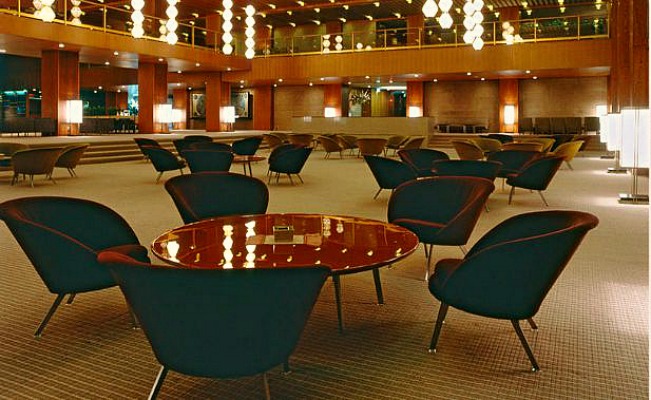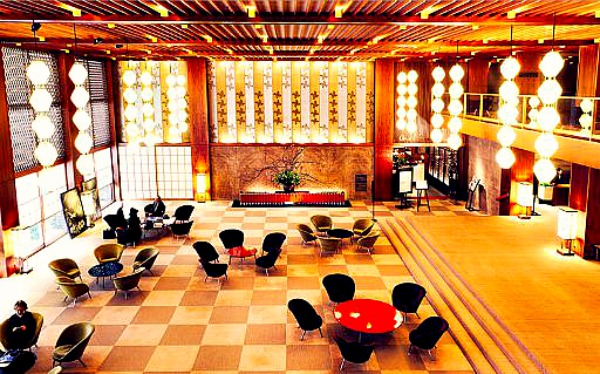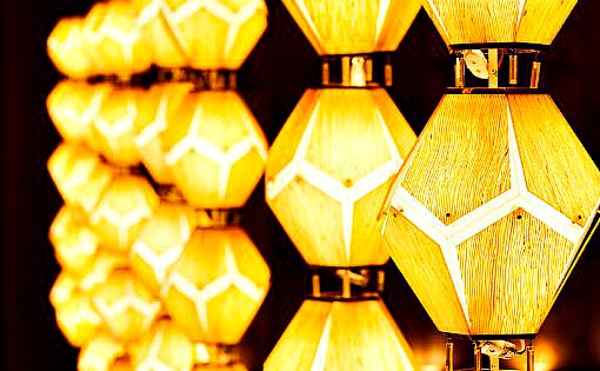Farewell To A Mid-Century Landmark: Tokyo’s Hotel Okura Closes Its Main Building (And Ends An Era)
By the time you read this, the last guest will have checked out of the Main Building of the Hotel Okura, and one of Tokyo’s most distinctive (and beloved) mid-century buildings will be shuttered. In the coming weeks, workers will dismantle the 53-year-old structure, prepping it for the wrecker’s ball so a pair of sky-scraping glass towers boasting hotel rooms and commercial space can rise on the site in time for the 2020 Tokyo Olympics.

Midcentury mod: the Okura Main Building lobby. (photo from savetheokura.com)
Old buildings topple every day to make way for new, particularly in Tokyo, an old city that, thanks to a tumultuous history of earthquakes, fires and wars, doesn’t have much that compares in age to Rome’s basilicas, London’s palaces or Istanbul’s mosques. Still, it never occurred to me that the Okura’s Main Building, a structure of unmatched architecture, history and craftsmanship, was the hotel equivalent of a Sumatran Tiger.
I have a history with the Okura. I lived in an apartment across the street when I moved to Tokyo as a young journalist in the early 1980s. I ate my first meal in Japan at the Okura’s Camellia Coffee Shop — curried chicken with rice followed by a gin/tonic, as the servers called it, in the Highlands Bar. For the next two and a half years, there was barely a day I didn’t stop by the hotel. I’d check the AP and Reuters wires clicking in an alcove, conduct interviews in the lobby seated in a seek cinnamon-colored chair, pick up newspapers at the gift shop and try out the restaurants (repeatedly). I’ve never had mapu tofu as eye-watering (or enjoyable) as the fiery concoction served in the Okura’s blood-red Chinese restaurant Toh-Ka-Lin.

Closed but still standing for now. (Wikipedia photo)
Like an older, expat Eloise, I found life in the Okura orbit endlessly entertaining. I saw Jimmy Carter breeze through the lobby and watched Richard Nixon bark orders at an aide as he exited the building. My favorite sumo wrestlers paraded through majestically, wrapped in blue and white yukatas. I was even an Okura employee of sorts, writing occasionally for the slick English-language magazine the hotel placed in guest rooms.
But what I remember most about the Okura is what it taught me about Japan. Opened as a showpiece for the 1964 Tokyo Olympics, the Okura was modern, but it wasn’t Western. It was sumptuous but never ostentatious. At every turn it quietly showcased Japan’s deep, rich culture, an eye-dazzling primer for anyone who paid attention. Look hard enough and you’d see the seeds of modernism in Japanese design that dated from centuries ago.

In the lobby the ultimate luxury in a space-starved city: elbow room.
A low, wide structure faced in gray brick and a subdued medley of decorative tiles, the hotel commanded the top of a modest hill, serene and stately as a Buddha. In a city where spaciousness is the ultimate luxury, the lobby was swimming in elbow room, its double-height ceiling beamed in honey-colored wood and lined with twin rows of long paper lanterns. Light from outside beamed in through shoji screens.
At first glance, the furniture appeared to be unadulterated ‘60s fare, the kind you’d find at New York’s Four Seasons restaurant (or Don Draper’s apartment): trim fabric chairs (part Eames, part Womb) perched on thin metal legs and sleek round tables. But look closely and you’d see a room as deliberately composed as a kaiseki meal, with careful groupings of those chairs (always five or six; four is considered bad luck) surrounding each table like the petals of a flower. Master craftsmen painstakingly created the red lacquer tables in the traditional manner. A low ledge abutting a wall showcased flower arrangements devised by an Ikebana school.
The cultural celebration continued outdoors in the back with a manicured Japanese garden and reflecting pond. In 1973, a second building, the South Wing, went up, also designed by architects Yoshiro Taneguchi and Hideo Kosaka. Though newer and at 13 stories, taller, it was a true child of the 70s and didn’t wow quite like the original. Still, it, too, had magic.
I could picture other Tokyo hotels like the Keio Plaza or the Imperial in New York or Hong Kong or almost anywhere, but never the Okura. It even boasts its own tile-roofed museum housing a handsome collection of Japanese swords, calligraphy and paintings.

Okura lanterns before the lights went out for the last time.
So why are they destroying the Main Building? It’s showing its age. Carpets are frayed, and the rooms require significant work to take on a new generation of glittering competitors like the Peninsula, Mandarin Oriental and Park Hyatt. Though the hotel has successfully weathered countless tremors in its 53 years, it lacks 21st-century protection from earthquakes. Costly fixes all — and they still wouldn’t buy a buzzy new hotel (James Bond visited in You Only Live Twice, but it’s hard to imagine Sophia Coppola’s hip Lost in Translation unfurling at the Okura).
What the decision makers had is a generous piece of property in a prime location and a classic conundrum. Preservationists, including Bottega Veneta creative director Tomas Maier and an impressive line-up of architects, wags and scholars from Japan and beyond, have protested the building’s demise for months. (Monocle magazine’s online petition to save the Main Building is still live, if you’re so inclined.) But that apparently wasn’t enough to counterbalance the economic rewards of a grand-scale redevelopment for the construction and property companies involved. In a show of good faith, Yoshio Taniguchi, son of Yoshiro Taniguchi and a successful architect in his own right, was tapped to design the new property.
The other olive branch extended to Okura aficionados is the South Wing, which will remain untouched (for now). Small consolation. They’re tearing down the wrong building.

Very sad.
It seems it always boils down to money.
Heartbreaking. Thanks, Kim.
This makes me so sad. I wish people could recognize things for what they are – AND what they stand for.
So do I, Jessie. Thanks!
Excellent piece, Terry, and a sad reality that what’s iconic sometimes doesn’t have the staying power.
Aww!!! Sad news. 🙁 Thanks for the update.